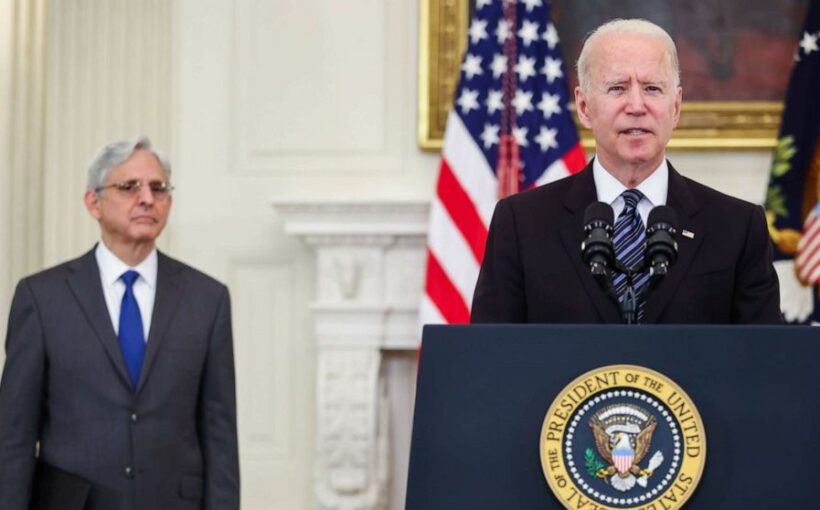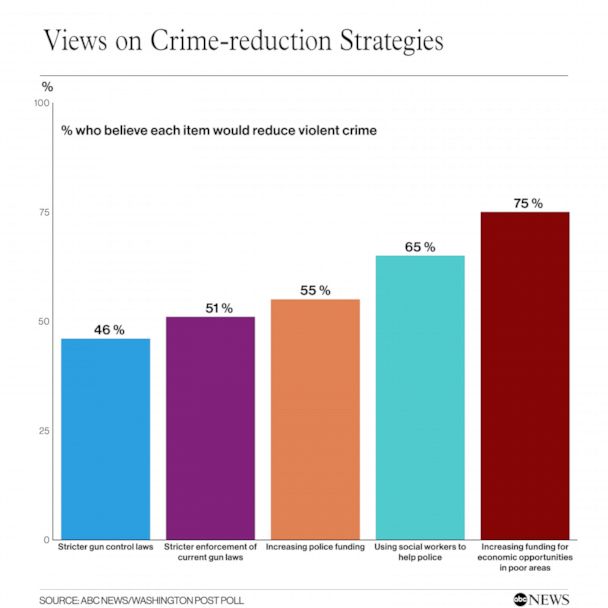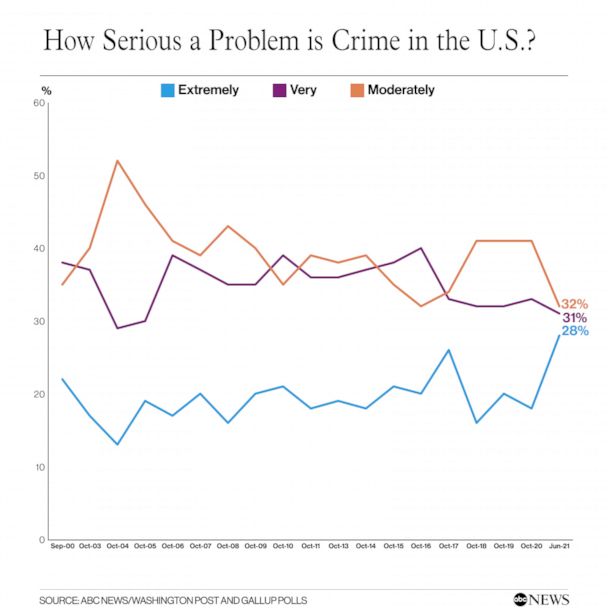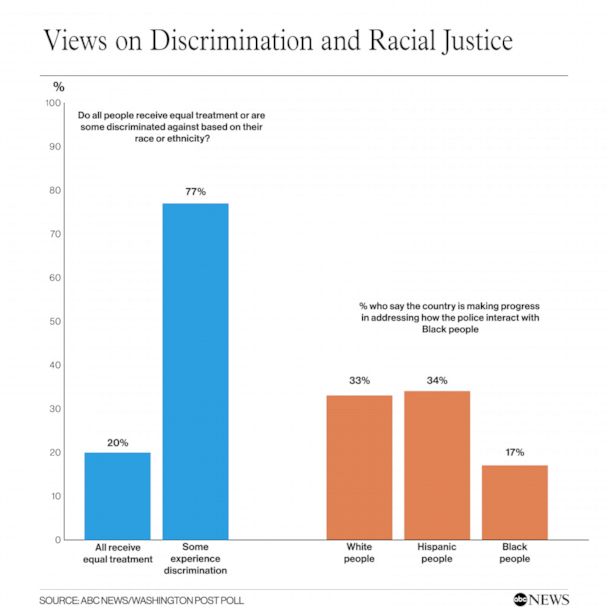The number of Americans seeing crime as an extremely serious problem in the United States is at a more than 20-year high, President Joe Biden is underwater in trust to handle it and broad majorities in an ABC News/Washington Post poll favor alternative crime-fighting strategies to address it.
A sweeping 75% in the national survey said violent crime would be reduced by increasing funding to build economic opportunities in poor communities. Sixty-five percent said the same about using social workers to help police defuse situations with people having emotional problems.
These measures, aimed at underlying causes of crime, are most apt to have been seen as effective, by substantial margins, of five that were tested. Among the others, 55% think increasing funding for police departments would reduce violent crime, 51% say the same about stricter enforcement of existing gun laws and 46% say so about stricter gun-control laws.
See PDF for full results and charts.
Broad support for alternative anti-crime measures comes against a backdrop of heightened high-level concern. Twenty-eight percent of Americans see crime in the United States as an extremely serious problem, a relatively small group but the most to hold this view compared to nearly annual polls by Gallup from 2000 to 2020. The average across those previous polls is 19%.
This poll, produced for ABC News by Langer Research Associates, finds a troubling difference in the experience of crime along racial and ethnic lines. While 13% of white people and 17% of Hispanic people call crime an extremely or very serious problem in the area where they live, this jumps to 31% among Black people.
Politically, just 38% of adults overall approve of how Biden is handling the issue of crime in this country, with 48% disapproving. That said, Americans divide almost exactly evenly on which political party they trust more to handle crime — 36% pick the Republicans, 35% the Democrats, about the average difference between the parties on this question in polls going back to 1990. Twenty percent volunteered that they don’t trust either party on crime.
Crime Strategy/Groups
Views on crime-reduction strategies differ among groups, sometimes sharply, with especially sizable gaps among Black people — who, as noted, are more apt to see crime as a serious problem in their area — compared with others.
For example, Black people are vastly more apt than white people to say stricter gun control laws would reduce violent crime, 76% versus 37%, and to see stricter enforcement of existing gun laws as effective, 75 to 45%. Hispanics fall in between, at 57%, on both. At the same time, Black people are far less likely than white people to see increased funding for the police as a way to reduce crime, 39 versus 60%, likely given Black people’s experiences of unequal treatment by police, explored in previous ABC News/Washington Post polls. Again, Hispanics fall in between.
On alternative approaches, 83% of Black people said they think using social workers to help defuse situations with emotionally distressed people would reduce violent crime, as did 73% of Hispanics, dropping to 60% of white people. There’s less of a gap on building economic opportunities in poor communities — 87% of Black people, 81% of Hispanic people and 73% of white people said that they think this would reduce violent crime.
There are differences by age on nontraditional crime-reduction strategies. Among 18- to 29-year-olds, 82% said they see the use of social workers as effective; just 53% of seniors agreed. And while 87% of those younger than 30 thought building economic opportunities would reduce violent crime, that fell to 67% — still a robust majority — of seniors.
Both creating new gun control laws and more strictly enforcing existing gun laws were more apt to be seen as effective by women compared with men, in the more liberal Northeast compared with other regions, and in urban rather than suburban or, especially, rural areas.
Politics
There are well-established partisan and ideological fault lines on these approaches. Eighty-one percent of Democrats said they see stricter gun laws as effective in reducing violent crime, for example; 42% of independents and just 13% of Republicans agreed.
Many Republicans also were skeptical about using social workers — 42% said they think this would reduce violent crime. But more, 61% of Republicans, saw increasing spending to enhance economic opportunities in poor areas as effective. That rose to 76% of independents and nearly all Democrats, 90%.
Other results underscored the country’s sharp partisan lines on political issues. Just 6% of Republicans and 35% of independents approved of Biden’s work on crime, compared with 74% of Democrats.
With an eye toward the 2022 midterm elections, Biden’s party showed potential vulnerability on crime in two hotspots: the Midwest, where the Republican Party leads the Democrats in trust to handle crime, 43-28%; and in the suburbs, a 43 to 31% GOP advantage. Crime, as such, looks set to play a prominent role in the political debate in the months ahead.
Methodology
This ABC News/Washington Post poll was conducted by landline and cellular telephone June 27-30, 2021, in English and Spanish, among a random national sample of 907 adults. Results have a margin of sampling error of 3.5 percentage points, including the design effect. Partisan divisions are 30-24-37%, Democrats-Republicans-independents.
The survey was produced for ABC News by Langer Research Associates of New York, New York, with sampling and data collection by Abt Associates of Rockville, Maryland. See details on the survey’s methodology here.
Source: Read Full Article



